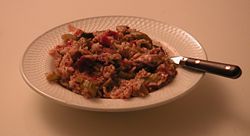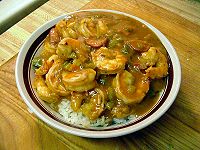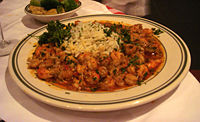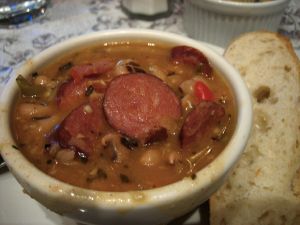Jambalaya
Jambalaya (pronounced /ˌdʒʌmbəˈlaɪə/ or <jum-buh-LIE-uh>) is a casserole-style dish of Spanish and French influence originating in Louisiana. Jambalaya is traditionally a one pot dish, with a variety of meats and seafood, vegetables, and spicy seasonings. The dish is completed by adding raw rice to the pot's stock, and the rich stock flavor is absorbed by the grains as the rice cooks. Both creole and cajun versions exist; the Creole variety, considered original, is also known as "red jambalaya" due to the inclusion of tomatoes.
Preparation
Rice stews have a long lineage in the culinary traditions of the French, Spanish, African, and Native Americans, and the quintessential melting pot of New Orleans owes some of its culinary distinction to these influences. However, jambalaya (and many local cousin dishes) has a distinct Louisiana parentage in its native bayou ingredients. Cajun Jambalaya originates from Louisiana's rural, low-lying swamp country where crawfish, shrimp, oysters, alligator, duck, turtle, boar, venison, and other wild game were readily available. Any variety or combination of meats, including chicken or turkey may be used to make jambalaya. This flexibility of ingredients together with its stimulating flavors have made Jambalaya a satisfying favorite of cooks and diners both affluent and poor, ensuring its enduring popularity.
There are two primary methods of making jambalaya—Creole and Cajun. Cajun food is considered the "rough-around-the-edges" robust food of the countryside, most often characterized by a very dark roux, very spicy flavor, and includes significant amounts of animal fat. Creole food tends to be more refined "city" food with greater emphasis on the use of cream and butter.[1]
The original and more common method, Creole jambalaya, is also called "red jambalaya" because it includes tomatoes. First, meat is added, usually chicken and sausage such as andouille or smoked sausage. Next vegetables and tomatoes are added to cook, followed by seafood. Rice and stock are added in equal proportions at the very end. The mixture is brought to a boil and left to simmer for 20 to 60 minutes, depending on the recipe, with infrequent stirring. Towards the end of the cooking process, stirring usually ceases.
The second style, more characteristic of southwestern and south-central Louisiana, is Cajun jambalaya, which contains no tomatoes. The meat is browned in a cast-iron pot. Pieces of meat sticking to the bottom of the pot are what give Cajun jambalaya its brown color. When cooked, the meat is removed to a separate plate. A little vegetable oil is added if there is not enough fat in the pot. The " trinity" (of onions, celery, and green bell pepper) is added and sautéed until soft. Stock and seasonings are added in the next step, and then the meats are returned to the pot. This mixture is then simmered, covered, for at least one hour. Lastly, the mixture is brought to a boil and rice is added to the pot. It is then covered and left to simmer over very low heat for at least 1/2 hour without stirring. The dish is finished when the rice has cooked.
A third method, called "white Jambalaya," is less common. In this version, meat and vegetables are cooked separately from the rice. At the same time, rice is cooked in a savory stock and then added to the meat and vegetables before serving. This dish is rare in Louisiana as it is seen as a "quick" attempt to make jambalaya, popularized outside the state to shorten cooking time.
History
Jambalaya originated from the original European sector of New Orleans (known as the "French Quarter" or Vieux Carré), and likely was an attempt by the Spanish to make paella in the New World. Saffron was not readily available, and so tomatoes became a substitute. Over time, spices from the Caribbean changed this New World "paella" into a unique dish.
Cajun Jambalaya has more of a smoky and spicy flavor than its cousin Creole Jambalaya. It was adopted after absorption of white French Creoles into the Cajun population following their fall from power in New Orleans after the Civil War. [2]
Etymology
Fittingly for a product of Cajun culture, the word "jambalaya" seems to have as many possible origins and authors as the complex dish has ingredients and variations—and most of these are easier to discredit than to verify. Until very modern times, Louisiana cooking was largely confined to the local region. The result is a meager written record of the area's food history, and folklore has often became “fact.”
The most commonly repeated folklore is that the word derives from the combination of the French jambon meaning ham, the French article à la a contraction of à la manière de meaning "in the style of," and ya, thought to be of West African origin meaning rice. Hence, the dish was named "jamb à la ya." However, ham is not the signature ingredient of the dish and there is no known African language in which "ya" means "rice."
Another popular source suggests that the word comes from the Spanish jamon (ham) + paella, a noted Spanish rice dish. However, Spanish speakers would call a ham paella paella con jamon, not jamon paella.
There is also a popular old wives' tale about the origin of the word "jambalaya":
Late one evening a traveling gentleman stopped by a New Orleans inn which had little food remaining from the evening meal. The traveler instructed the cook, "Jean, balayez!" or "Jean, sweep something together!" in the local dialect. The guest pronounced the resulting hodge-podge dish as "Jean balayez."[3]
The first print appearance of any variant of the word "jambalaya" in any language occurred in Leis amours de Vanus; vo, Lou paysan oou théâtré, by Fortuné (Fourtunat) Chailan, first published in Provencal in 1837. This is an excerpt:
- The upstairs neighbors were making a din
- All kinds of people, rich and poor:
- It was a mish-mash [jambaraya] of red inebriated faces;
- As in the song birds that we have in October,
- All kinds of birds were singing.
It is also found in a poem by Louis Charles Felix Peise, La Testo et la Coua de la Serp, from his book Leis Talounados de Barjomau (1865):
- Mathew said to me: He is a rioter!
- James said to me: He was our safeguard;
- But all that does not agree,
- However each of us knows how the boat is going.
- This rabble [jambalaia] reminds me
- Of the arrival of an old snake,
- When its tail wanted the air
- To pass in front. Here’s the story;
- The tail gave as argument
- It had been there for too long!
Both publications are French and neither example used the word in a culinary sense. In both cases it indicates a mish-mash, rabble, or mixture—a meaning that lends itself well to Jambalaya.[4]
The earliest appearance of the word in print in English occurs in the May 1849 issue of the American Agriculturalist, where Solon Robinson refers to a recipe for "Hopping Johnny (jambalaya)." An article in the 1875 New Orleans Times said it was “spelled in French jumbliade; but the dish is of Indian origin” and “originally made of zizania aquatica, or wild rice.” Jambalaya did not appear in a cookbook until 1878, when The Gulf City Cook Book, by the Ladies of the St. Francis Street Methodist Episcopal Church, was printed in South Mobile, Alabama. It contains a recipe for “JAM BOLAYA.”[5]
The spoken language is normally in use for some time before it appears in print, leading to the assumption that the word Jambalaya was in the lexicon somewhere prior to its appearance in these publications.
Nutrients
Jambalaya is teeming with nutrients, but the variety, quantities, and ratio of ingredients makes nutritional breakdown subject to the creativity of the chef, who has full license to make each preparation different from one another. In general, the dish is heavy on proteins and spice, with starch and vegetables running behind. One jambalaya recipe offers this breakdown of nutrients.[6]
- Calories: 691
- Fat: 26g
- Fiber: 4g
- Carbohydrates: 67g
- Sodium: 1778mg
- Cholesterol: 151mg
- Protein: 44g
Cultural significance
Starting with church fairs, which were the largest public gatherings during the nineteenth and twentieth centuries, Jambalaya emerged from small quantity indoor cooking to become the ideal dish for outdoor cooking over hardwood fire. Big black cast iron pots made preparation so easy and economical for church use that Jambalaya was rapidly adapted for political rallies, weddings, family reunions, and other affairs.
The country song, "Jambalaya," written by Moon Mullican and Hank Williams Sr. celebrates the dish. Hank Williams copied the Jambalaya musical melody from an earlier tune recorded in Cajun French called "Grand Texas." The song has been re-recorded with Hank Williams' words translated into Cajun French. Cajuns now consider it to be one of their own songs.[7]
In 1968, Louisiana Governor John J. McKeithen proclaimed Gonzales, Louisiana, the Jambalaya Capital of the World. Every spring, the annual Jambalaya Festival is held in Gonzales.
Jambalaya is also a popular dish in many Ready-to-Eat Meals (MRE) for the military. Also, Jambalaya was a popular MRE during the crisis of homelessness after Hurricane Katrina.
Similar dishes
Dishes similar to, but distinct from, jambalaya exist both in cuisine and Cajun cuisines of Louisiana and in dishes from other parts of the world.
Louisana
Rice is the ingredient that distinguishes Jambalaya from gumbos and étouffées, each of which is made without rice but is served over rice that has been prepared separately. Jambalaya is considered by most Louisianians to be a simple to prepare, yet filling, rice dish; gumbos and étouffées are considered more difficult to perfect.
- Gumbo
Gumbo is a stew or soup originating in Louisiana, and found across the Gulf Coast of the United States and into the U.S. South. The dish is based on the French soup bouillabaisse, the Spanish "holy trinity" of celery, bell peppers and onion, and the use of filé powder (ground sassafras leaves) which is Native American. But the dish got its name from the French interpretation of the West African vegetable okra.
A typical gumbo contains one or more kinds of poultry, shellfish, and smoked pork. Poultry used is typically chicken, duck, or quail. Local shellfish such as the freshwater crayfish, crab, and shrimp from the Gulf of Mexico are frequently used. Tasso and andouille provide a smoky flavor to the dish. The soup is traditionally served over rice.
- Etouffée
Étouffée is typically served with shellfish or chicken over rice, similar to gumbo, very popular in New Orleans and in the bayou country of the southernmost half of Louisiana. In étouffée the main ingredient originally was crayfish, and purists do not consider the dish to be étouffée unless crayfish is at least included in the ingredients.
- Hopping John
Hopping John is a much simpler dish than Jambalaya, but old-time recipes sometimes used these two names interchangeably, adding to the perception of Louisiana casserole dishes as initially being a mishmash of interchangeable ingredients and names that eventually settled into established preparations. It is the Southern United States' version of the rice and beans dish traditional throughout the Caribbean. It consists of field peas or crowder peas (black-eyed peas) and rice, with chopped onion and sliced bacon, seasoned with a little salt.
Dishes from elsewhere
Dishes in which rice and other ingredients are cooked together (the signature feature of jambalaya) are common in other cuisines. Some of the most similar are mentioned here:
- Paella
Paella is a rice and seafood or meat dish which originated in the community of Valencia, near lake Albufera, a lagoon in eastern Spain. Spaniards consider paella to be one of their national dishes. Valencian paella consists of white rice, green vegetables, meat, snails, beans, and seasoning. Seafood paella replaces meat and snails with seafood and omits beans and green vegetables. Mixed paella is a free-style combination of meat, seafood, and sometimes beans.
- Pilaf
Pilaf is a dish in which a grain, such as rice or cracked wheat, is browned in oil, and then cooked in a seasoned broth. Depending on the local cuisine it may also contain a variety of meat and vegetables. Pilaf and similar dishes are common to Middle Eastern, Central and South Asian, Latin American, and Caribbean cuisine.Pilaf and similar dishes are common to Middle Eastern, Central and South Asian, Latin American, and Caribbean cuisine.
- Risotto
Risotto is a rich and creamy, traditional Italian rice dish. It is one of the most common ways of cooking rice in Italy. There are many different risotto recipes with different ingredients, but they are all based on rice of an appropriate variety cooked in a standard procedure. Risotto can be made using many kinds of vegetable, meat, fish, seafood and legumes, and different types of wine and cheese may be used.
Notes
- ↑ Terry Thompson-Anderson, Cajun-Creole Cooking (Shearer Publishing, 2003, ISBN 978-0940672741).
- ↑ River Parishes Tourist Commission, "Jambalaya," New Orleans Plantation County Chronicle 3(3) (Fall 2008): 1. Retrieved February 18, 2009.
- ↑ John F. Mariani, Dictionary of American Food and Drink. (Hearst Books, 1994, ISBN 978-0688101398).
- ↑ Andrew Sigal, Jambalaya by any other name Petits Propos Culinaires 84, 2007/2008. Retrieved February 13, 2009.
- ↑ St. Francis Street Methodist Episcopal Church, South (Mobile, Ala.), and Aid Society, Gulf City Cookbook (South Mobile, AL: University of Alabama Press, l878). Retrieved February 13, 2009.
- ↑ Jamie Shannon, "Commander's Krewe Jambalaya," Cooking.com, 2008. Retrieved February 18, 2009.
- ↑ Clarence's Baton Rouge Information & Cajun/Zydeco Music Guide, Jambalaya Lyrics - cajun interpretation, history by Clarence, 2009. Retrieved February 13, 2009.
ReferencesISBN links support NWE through referral fees
- Mariani, John F. Dictionary of American Food and Drink. Hearst Books, 1994. ISBN 978-0688101398
- Thompson-Anderson, Terry, "Cajun-Creole Cooking." Shearer Publishing. 2003. ISBN-13: 978-0940672741
- Andrew Sigal, "Jambalaya by any other name." Petits Propos Culinaires 84. 2007/2008.
External links
- Cajun jambalaya recipe from Gonzales, Louisiana native.
- Jambalaya Recipe
- Vegetarian Jambalaya
- Chronology of all early mentions of Jambalaya in print.
- Article detailing how to make jambalaya for 120 people
- Anecdotal history of Jambalaya & recipes.
- Award winning Jambalaya recipe.
Credits
New World Encyclopedia writers and editors rewrote and completed the Wikipedia article in accordance with New World Encyclopedia standards. This article abides by terms of the Creative Commons CC-by-sa 3.0 License (CC-by-sa), which may be used and disseminated with proper attribution. Credit is due under the terms of this license that can reference both the New World Encyclopedia contributors and the selfless volunteer contributors of the Wikimedia Foundation. To cite this article click here for a list of acceptable citing formats.The history of earlier contributions by wikipedians is accessible to researchers here:
The history of this article since it was imported to New World Encyclopedia:
Note: Some restrictions may apply to use of individual images which are separately licensed.







